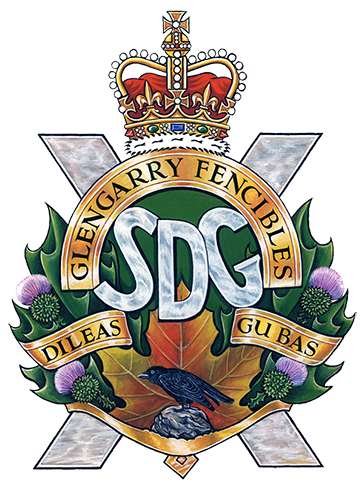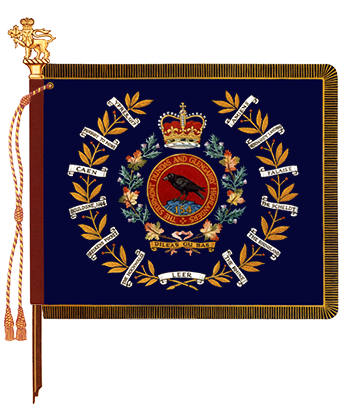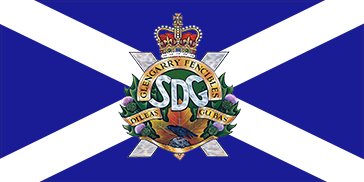Stormont, Dundas and Glengarry Highlanders
The official lineage of the Stormont, Dundas and Glengarry Highlanders infantry regiment.

Badge
Description
A pomme surmounted in base by an autumnal maple leaf flanked by thistles proper all issuant from a pair of barnacles Or ensigned by a raven close perched on a rock proper, and in chief by the letters SDG Argent below a scroll Or inscribed GLENGARRY FENCIBLES and above two like scrolls inscribed DILEAS and GU BAS, the whole ensigned by the Royal Crown proper and surmounting a saltire Argent.
Symbolism
The maple leaf represents service to Canada, and the crown, service to the Sovereign. The thistles (the national flower of Scotland) and the Cross of St. Andrew (the patron saint of Scotland) are common devices among badges of highland infantry regiments. The raven perched on a rock is from the badge and motto of the Clan MacDonnell of Glengarry, which is the clan tartan the regiment wears. The words "GLENGARRY FENCIBLES" are in memory of the service of the Glengarry Light Infantry Fencibles (1812-1816) who were raised during the War of 1812 in the regiment's recruiting area. "SDG" is an abbreviated form of the regimental title and "DILEAS GU BAS" is the motto of the regiment.
Motto
DILEAS GU BAS (Faithful unto death)
March
"Bonnie Dundee"
Regimental colour

Camp flag

Battle honours
The War of 1812
DEFENCE OF CANADA – 1812-1815 – DÉFENSE DU CANADA; CRYSLER’S FARM; NIAGARA (the latter honour awarded in commemoration of the Glengarry Light Infantry Fencibles)
Honorary Distinction
The non-emblazonable honorary distinction DEFENCE OF CANADA – 1812-1815 – DÉFENSE DU CANADA
The First World War
HILL 70; YPRES, 1917; AMIENS; ARRAS, 1918; HINDENBURG LINE; PURSUIT TO MONS.
The Second World War
NORMANDY LANDING; CAEN; The Orne (Buron); BOURGUÉBUS RIDGE; Faubourg de Vaucelles; FALAISE; The Laison; Chambois; Boulogne, 1944; THE SCHELDT; Savojaards Plaat; Breskens Pocket; THE RHINELAND; Waal Flats; The Hochwald; THE RHINE; Zutphen; Leer; NORTH WEST EUROPE, 1944-1945.
South-West Asia
AFGHANISTAN
Lineage
This Reserve Force regiment originated in Cornwall, Ontario on 3 July 1868, when the '59th "Stormont and Glengarry Battalion of Infantry"' was authorized to be formed.Footnote 1 It was redesignated: '59th "Stormont" Battalion of Infantry' on 22 June 1883;Footnote 2 '59th Stormont and Glengarry Battalion of Infantry' on 23 March 1888;Footnote 3 '59th Stormont and Glengarry Regiment' on 8 May 1900;Footnote 4 'The Stormont and Glengarry Regiment' on 12 March 1920;Footnote 5 'The Stormont, Dundas and Glengarry Highlanders' on 15 February 1922;Footnote 6 '2nd (Reserve) Battalion, The Stormont, Dundas and Glengarry Highlanders' on 7 November 1940;Footnote 7 'The Stormont, Dundas and Glengarry Highlanders' on 24 May 1946;Footnote 8 'The Stormont, Dundas and Glengarry Highlanders (Machine Gun)' on 1 September 1954;Footnote 9 and 'Stormont, Dundas and Glengarry Highlanders' on 1 August 1959.Footnote 10
Notes:
Upon redesignation as The Stormont and Glengarry Regiment on 12 March 1920 (see above), it was organized as a two battalion regiment with the 1st Battalion (154th Battalion, CEF) on the Non Permanent Active Militia order of battle and the 2nd Battalion (no CEF designation) on the Reserve order of battle. The reserve unit was disbanded on 14 December 1936 (GO 3/37).
The Stormont and Glengarry Regiment was disbanded for the purpose of reorganization on 15 June 1920 and reorganized the same day (GO 135/20). This change was administrative and does not affect the lineage of the regiment.
Perpetuations
‘1st Regiment of Dundas Militia (1812-15)’, ‘1st and 2nd Regiments of Glengarry Militia (1812-15)’, ‘1st Regiment of Prescott Militia (1812-15)’, ‘1st Regiment of Stormont Militia (1812-15)’, and '154th "Overseas" Battalion, CEF'
Operational history
The Fenian Raids
The battalion was called out on active service on 24 May 1870. It served on the St. Lawrence River frontier and was removed from active service on 1 June 1870.Footnote 11
The First World War
Details of the 59th Stormont and Glengarry Regiment were placed on active service on 6 August 1914 for local protection duties.Footnote 12
The 154th Battalion, which was authorized on 22 December 1915 as the '154th "Overseas" Battalion, CEF',Footnote 13 embarked for Britain on 25 October 1916.Footnote 14 It provided reinforcements for the Canadian Corps in the field until 31 January 1917, when its personnel were absorbed by the '6th Reserve Battalion, CEF'.Footnote 15 The battalion was disbanded on 17 July 1917.Footnote 16
The Second World War
Details from the regiment were called out on service on 26 August 1939 and then placed on active service on 1 September 1939, under the designation 'The Stormont, Dundas and Glengarry Highlanders, CASF (Details)', for local protection duties.Footnote 17 The details called out on active service were disbanded on 31 December 1940.Footnote 18
The regiment mobilized the 'The Stormont, Dundas and Glengarry Highlanders, CASF' for active service on 24 May 1940.Footnote 19 It was redesignated the '1st Battalion, The Stormont, Dundas and Glengarry Highlanders, CASF' on 7 November 1940.Footnote 20 This unit embarked for Britain on 19 July 1941.Footnote 21 On D-Day, 6 June 1944, it landed in Normandy, France, as part of the 9th Infantry Brigade, 3rd Canadian Infantry Division, and it continued to fight in North West Europe until the end of the war.Footnote 22 The overseas battalion was disbanded on 15 January 1946.Footnote 23
The regiment subsequently mobilized the '3rd Battalion, The Stormont, Dundas and Glengarry Highlanders, CIC, CAOF' on 1 June 1945 for service with the Canadian Army Occupation Force in Germany.Footnote 24 The battalion was disbanded on 24 May 1946.Footnote 25
South-West Asia
From 2002 to 2014, Stormont, Dundas, and Glengarry Highlanders reinforced various CAF units deployed to Afghanistan.Footnote 26